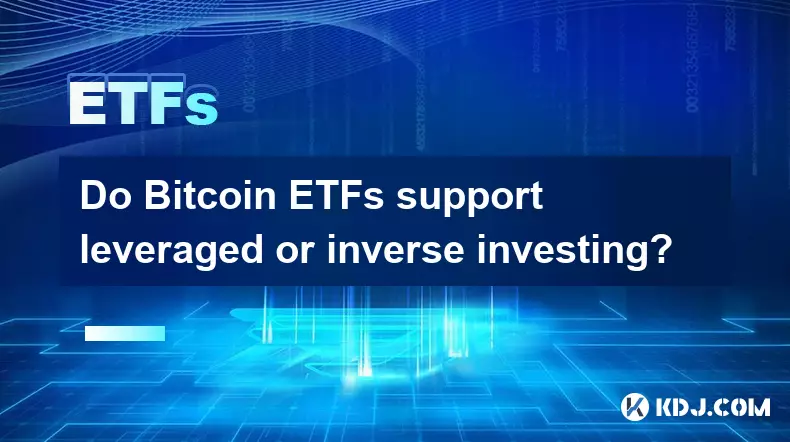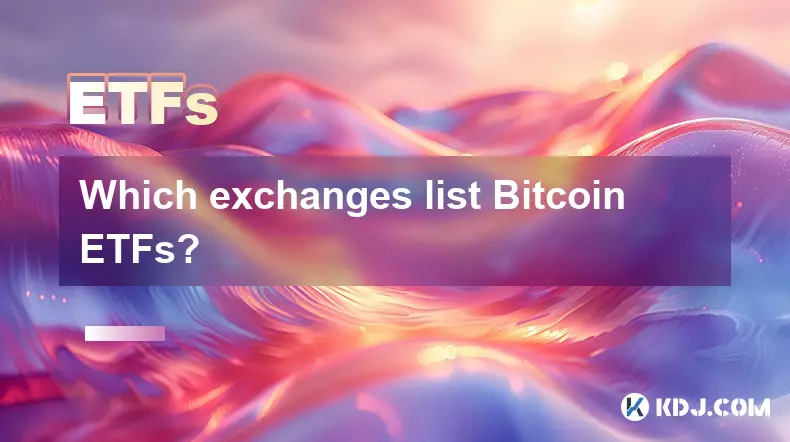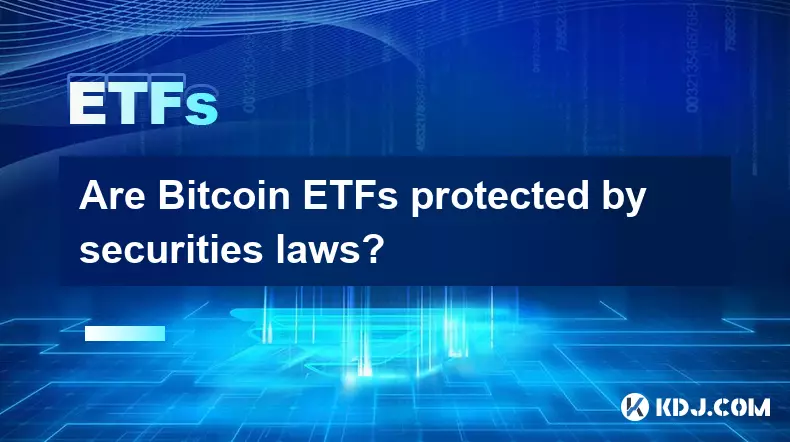-
 bitcoin
bitcoin $124586.364639 USD
0.62% -
 ethereum
ethereum $4670.671710 USD
3.33% -
 xrp
xrp $2.983701 USD
0.18% -
 tether
tether $1.000175 USD
-0.03% -
 bnb
bnb $1209.430642 USD
2.76% -
 solana
solana $231.365861 USD
0.51% -
 usd-coin
usd-coin $0.999665 USD
-0.02% -
 dogecoin
dogecoin $0.264657 USD
4.46% -
 tron
tron $0.346415 USD
1.60% -
 cardano
cardano $0.871586 USD
3.70% -
 chainlink
chainlink $23.451270 USD
7.56% -
 hyperliquid
hyperliquid $46.860071 USD
-2.96% -
 ethena-usde
ethena-usde $1.000120 USD
0.04% -
 sui
sui $3.611279 USD
1.08% -
 stellar
stellar $0.407149 USD
0.96%
Do Bitcoin ETFs support leveraged or inverse investing?
Bitcoin ETFs offer regulated, straightforward exposure to Bitcoin’s price without direct ownership, but leveraged or inverse versions remain unapproved due to volatility and investor protection concerns.
Sep 29, 2025 at 03:18 am

Understanding Bitcoin ETFs and Their Investment Structures
1. Bitcoin ETFs, or exchange-traded funds, are investment vehicles that track the price of Bitcoin and trade on traditional stock exchanges. These funds allow investors to gain exposure to Bitcoin without directly owning or storing the cryptocurrency. Most Bitcoin ETFs available today are designed to reflect the spot price of Bitcoin, meaning their value rises and falls in direct correlation with Bitcoin’s market price.
2. The structure of these ETFs is regulated and standardized to ensure transparency and compliance with financial authorities. Because they are listed on regulated exchanges, they must adhere to strict guidelines that often exclude complex derivatives-based strategies. This regulatory framework limits the types of financial instruments these ETFs can include in their portfolios.
3. As a result, the majority of approved Bitcoin spot ETFs do not incorporate leverage or inverse mechanisms. They are built for long-term investors seeking straightforward market exposure rather than speculative trading tools. The focus remains on replicating the underlying asset’s performance accurately and safely.
4. Some financial institutions have explored launching leveraged or inverse Bitcoin ETFs, but regulatory bodies like the U.S. Securities and Exchange Commission (SEC) have expressed concerns about investor protection, volatility, and market manipulation risks. These concerns have led to repeated rejections or delays in approving such products.
5. While leveraged and inverse ETFs exist in traditional markets—such as those based on the S&P 500—the same level of acceptance has not been extended to Bitcoin-based versions. The inherent volatility of cryptocurrency markets amplifies the risks associated with leverage, making regulators cautious about permitting these structures under the ETF umbrella.
Leveraged Investing in the Context of Crypto Assets
1. Leveraged investing involves using borrowed capital or financial derivatives to increase the potential return of an investment. In crypto markets, traders often access leverage through futures contracts, margin trading on exchanges, or specialized derivative platforms. These methods allow positions of 2x, 5x, or even higher relative to the initial investment.
2. Despite the availability of leveraged trading in decentralized and centralized crypto platforms, this functionality is absent from most regulated Bitcoin ETFs. The reason lies in the risk profile: leveraged products can lead to significant losses, especially in highly volatile markets like Bitcoin, where price swings of 10% or more in a single day are not uncommon.
3. Regulated ETFs prioritize capital preservation and accessibility for retail investors. Introducing leverage would contradict this objective by exposing unsophisticated investors to amplified downside risk. For this reason, fund issuers and regulators maintain a conservative stance toward including leveraged strategies in ETF formats.
4. There are over-the-counter (OTC) products and private funds that offer leveraged exposure to Bitcoin, but these are typically restricted to institutional or accredited investors. They operate outside the public ETF framework and are not subject to the same disclosure and liquidity requirements.
5. The absence of leveraged Bitcoin ETFs does not eliminate demand for such instruments. However, the gap is filled by alternative vehicles like perpetual futures contracts on exchanges such as BitMEX, Bybit, or Deribit, which provide high leverage but come with elevated counterparty and liquidation risks.
Inverse Strategies and Market Demand
1. Inverse investing aims to profit from declining prices by taking short positions. An inverse ETF increases in value when the underlying asset decreases. In traditional finance, inverse ETFs are used as hedging tools or bearish bets during downturns.
2. Currently, there are no widely available inverse Bitcoin ETFs approved for trading in major markets like the United States. Regulatory hesitation stems from the difficulty of maintaining consistent inverse exposure over time, particularly in volatile assets where compounding effects can distort performance.
3. Some countries have allowed limited forms of inverse crypto-linked funds, but these are often structured as exchange-traded notes (ETNs) or private investment vehicles rather than true ETFs. These products may use swaps or futures to achieve inverse returns but lack the transparency and oversight of regulated ETFs.
4. Investor interest in bearish strategies remains strong, especially during prolonged bear markets or periods of macroeconomic uncertainty. However, the lack of accessible inverse ETFs means most short exposure occurs through futures markets or lending platforms where users borrow Bitcoin to sell it immediately, hoping to buy back at a lower price.
5. The technical complexity of sustaining daily rebalancing in inverse ETFs, combined with Bitcoin’s unpredictable volatility, makes long-term tracking error a serious concern. This further discourages regulators from greenlighting such products under the ETF label.
Frequently Asked Questions
Can I get 3x leveraged exposure to Bitcoin through any ETF?No, currently no 3x leveraged Bitcoin ETFs are approved for trading in regulated markets such as the U.S. or Europe. Such products remain under review due to regulatory concerns over risk and stability.
Are there any inverse Bitcoin funds available to retail investors?Retail-accessible inverse Bitcoin ETFs are not available in most jurisdictions. Short exposure is typically achieved through futures contracts or crypto exchange platforms offering margin trading.
Why haven’t regulators approved leveraged Bitcoin ETFs yet?Regulators cite investor protection, market volatility, and the potential for rapid losses as primary reasons for withholding approval. The complexity of managing leverage within a transparent, daily-traded fund structure adds to the hesitation.
Do spot Bitcoin ETFs allow short selling?Yes, investors can short sell shares of spot Bitcoin ETFs through brokerage accounts, effectively betting on a decline in the ETF’s price. However, this is different from an inverse ETF, which automatically gains value when Bitcoin drops.
Disclaimer:info@kdj.com
The information provided is not trading advice. kdj.com does not assume any responsibility for any investments made based on the information provided in this article. Cryptocurrencies are highly volatile and it is highly recommended that you invest with caution after thorough research!
If you believe that the content used on this website infringes your copyright, please contact us immediately (info@kdj.com) and we will delete it promptly.
- BlockDAG, DOGE, HYPE Sponsorship: Crypto Trends Shaping 2025
- 2025-10-01 00:25:13
- Deutsche Börse and Circle: A StableCoin Adoption Powerhouse in Europe
- 2025-10-01 00:25:13
- BlockDAG's Presale Buzz: Is It the Crypto to Watch in October 2025?
- 2025-10-01 00:30:13
- Bitcoin, Crypto, and IQ: When Genius Meets Digital Gold?
- 2025-10-01 00:30:13
- Stablecoins, American Innovation, and Wallet Tokens: The Next Frontier
- 2025-10-01 00:35:12
- NBU, Coins, and Crypto in Ukraine: A New Yorker's Take
- 2025-10-01 00:45:14
Related knowledge

Will Bitcoin ETFs affect Bitcoin's decentralized nature?
Sep 24,2025 at 02:00am
Impact of Bitcoin ETFs on Market Accessibility1. Bitcoin ETFs have significantly lowered the barrier to entry for traditional investors who may not be...

How do arbitrage opportunities exist with Bitcoin ETFs?
Sep 30,2025 at 12:36am
Understanding Bitcoin ETF Arbitrage Mechanics1. Bitcoin ETFs trade on traditional stock exchanges, allowing investors to gain exposure to Bitcoin pric...

Which exchanges list Bitcoin ETFs?
Sep 26,2025 at 03:18am
Major Cryptocurrency Exchanges Offering Bitcoin ETFs1. The landscape of digital asset trading has evolved significantly with the introduction of Bitco...

Are Bitcoin ETFs protected by securities laws?
Sep 28,2025 at 03:00am
Regulatory Framework Surrounding Bitcoin ETFs1. Bitcoin ETFs operate within the boundaries of established securities regulations, primarily under the ...

What role does a Bitcoin ETF play in an investment portfolio?
Sep 27,2025 at 12:36am
Understanding the Function of a Bitcoin ETF in Portfolio Diversification1. A Bitcoin ETF allows traditional investors to gain exposure to cryptocurren...

Is the volatility of Bitcoin ETFs consistent with Bitcoin?
Sep 26,2025 at 01:18am
Bitcoin ETFs and Their Relationship to Bitcoin Price Movements1. Bitcoin ETFs are financial instruments designed to mirror the price of Bitcoin withou...

Will Bitcoin ETFs affect Bitcoin's decentralized nature?
Sep 24,2025 at 02:00am
Impact of Bitcoin ETFs on Market Accessibility1. Bitcoin ETFs have significantly lowered the barrier to entry for traditional investors who may not be...

How do arbitrage opportunities exist with Bitcoin ETFs?
Sep 30,2025 at 12:36am
Understanding Bitcoin ETF Arbitrage Mechanics1. Bitcoin ETFs trade on traditional stock exchanges, allowing investors to gain exposure to Bitcoin pric...

Which exchanges list Bitcoin ETFs?
Sep 26,2025 at 03:18am
Major Cryptocurrency Exchanges Offering Bitcoin ETFs1. The landscape of digital asset trading has evolved significantly with the introduction of Bitco...

Are Bitcoin ETFs protected by securities laws?
Sep 28,2025 at 03:00am
Regulatory Framework Surrounding Bitcoin ETFs1. Bitcoin ETFs operate within the boundaries of established securities regulations, primarily under the ...

What role does a Bitcoin ETF play in an investment portfolio?
Sep 27,2025 at 12:36am
Understanding the Function of a Bitcoin ETF in Portfolio Diversification1. A Bitcoin ETF allows traditional investors to gain exposure to cryptocurren...

Is the volatility of Bitcoin ETFs consistent with Bitcoin?
Sep 26,2025 at 01:18am
Bitcoin ETFs and Their Relationship to Bitcoin Price Movements1. Bitcoin ETFs are financial instruments designed to mirror the price of Bitcoin withou...
See all articles










































































